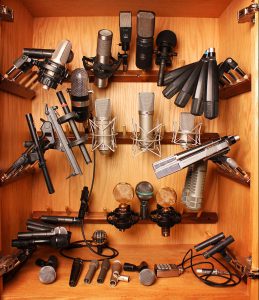
It’s been quite a few years since I was a cooing babe in my mother’s arms, but I’m told that even then I was one to sing out on occasion.
Whether that was life’s endless, flowing inspiration or just the earliest iteration of gas…who can say?
But one thing is certain: I’ve been singing for as long as I can remember. And that, my friends, is why I am so adamant about choosing the right studio recording microphone for each specific instrument we decide to use in the studio or on the stage.
The Alchemy of Sound…Shall Astound Thee!
So we don’t get lost in the boondocks of electronic transmogrification, let’s simply say that microphones are little, magic wizards (“Lord of the Rings”, “Harry Potter” or “Le Morte D’Arthur” version? I leave that to your preference) that turn our voice, or the sound of our instrument, into signals that can travel along cables like murmuring snakes, only to be reborn and held in the recording device at the other end, as the sound of our voice or instrument. Magic!

Ahh, but not all wizards are as trained as ol’ Merlin or Harry….or Saruman; some barely passed their first transfiguration exam.
And so, dear magicians, that is why we find such differences in the quality and sound of all the mics in the world. Some rise up in mastery! Others sink to noisy depths….and make our tracks, in a word….suck.
But who do we trust? How do we know which witch is which in the dark lairs of the mics?? I light my torch for you, inquisitive initiates, and whisper as we embark, “Stay cwose to the candles. The stairs….can be tweacherous….”
Battle of the Three Mic Armies
First, we shall gather here under the shadow of Mt. Doom and let the different types of mics duke it out. They never stop fighting, and they endlessly whine about which of them is ‘the obvious choice’ for all voices and instruments, each one believing they’re superlative to the task. No wonder there’ll never be world peace!
Here are the banners flying across the trampled plain:
- Dynamic mics
- Condenser mics
- Ribbon mics
These are the basic types. Each differ in the spell they use to transmogrify sound (ok, it’s really not a spell, but, just stay with me here….).
In each of them, there’s always a square or round diaphragm of various construction composites that is the ignition point for all the magic. But, unless you’re a tweaky engineer or something, I know you don’t care. What you do want to know is how that affects what you do. Here, then, in a nutshell, is what we’ve learned from our spies who have reconnoitered the three dueling camps:
Dynamic Mics:
They’re strong. They are durable. They’re ripped. They’re like “the Mountain” on Game of Thrones. Take these mics on tour with you and they’ll take the beating and still say, “Thank you, sir. May I have another!”, which is why they’re a ubiquitous presence in live sound.
They also can typically withstand loud sounds, withstanding, like a rock (nod to Bob!), what we call high SPL, or Sound Pressure Levels. You’ll find ’em on kick drums, snares, bass & guitar amps – basically anything that can WHAP you across the face and send you cryin’ for mommy.
These are your Warrior Wizards. They don’t mess around. They take names. You have been warned!
Condenser Mics:
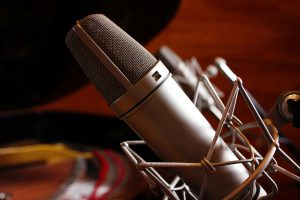
These are more sensitive than dynamic mics and can thus be damaged easier. Ya don’t wanna be throwing these across the stage into a mic box after every show!
These mics know every trick in the books tho’, which is why you’ll find them everywhere. Almost every amazing studio vocal recording is done with a condensor mic, tho’ there are exceptions.
They are also often the mic of choice for acoustic instruments and percussion, since they can really pick up transient (the very beginning of a sound) details if you want them to. Because of their acute sensitivities, they pick up nuances that may be lost to the Warrior Wizards.
They do not, however, like extremely loud treatment in most cases.
Oh, and they are the only one of the three that needs “phantom power”, which means you must plug this mic into some mixer or recording device that supplies p.p. or the mic will not work. It’s finicky. It’s entitled. It would demand the ‘King’ role on the chess board.
So treat these guys with respect. Or, ya know; they may turn you into a newt.
But…you’ll get better.
Ribbon Mics:
These are the most sensitive mics of all. Look at them askance and they might pull an Ozzy and bite your head off, you insensitive bat!
The transducer in a ribbon mic is “wafer thin”, but don’t get them anywhere near Mr. Creosote – they’re fragile!
Typically used for guitar amps, strings and drum overheads and room mics, they do produce a very pleasing, warm sound if set up correctly. But they’ll be fighting from behind walls, mountains, caves, boulders…anything to keep their frangible hearts safe.
Just remember, tho’…frail on the outside does not mean there’s not power on the inside. These exotic wizards from the nether worlds are rarely understood, but possess the ability to make your sound as beautiful as a Siren calling from the rocks.
It’s calling you…..calling you….calling y….
Let the War Drums Commence!
So that’s how the three camps differ. But, essentially, they’re all the same: they transduce the sound of your voice or instrument into electric current and reproduce it at the other end. So…which should we choose for any given sound?
Well, this is where you show if you’re serious about surviving the Battle of the Three Armies or not. You will either spend the time it takes to really know your options, or be trampled by their mass in ignorance and confusion. I suggest the former. It’s not that hard and will open your eyes and ears to new realms of possibility. It’s like this….
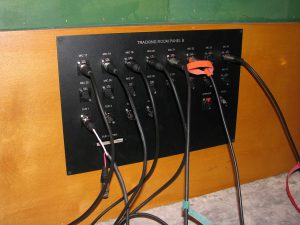
First, plug in all the mics you have. If you don’t have many, this’ll be reallly easy. If you have more, not so. But, trust me; it’ll be well worth it. It’s best if you can have all the mics plugged in simultaneously, but if you only have one or few inputs, this can be done in serial fashion and still provide insightful data.
Next, you or a musical compatriot must play a specific instrument, or sing, into all the mics. Have them arranged in a semi-circle around the sound source (i.e. your mouth or the best sound point of your instrument) so that none are farther or closer than any other.
Then, using a recording device, either software or hardware, push that red button and capture the spell being sung or played through all the mics, again, preferably at the same time.
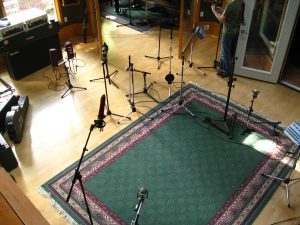
NOW you’re in for a treat. Sit back in front of good studio monitors, or headphones, and listen, reeeeeally listen to each mic, one at a time. If you never knew just how different your mics sound, this experiment will definitely draw back the curtain and show you just how divergent and distinctive each mic can be on the same sound source.
I have done this on almost every instrument I play. Why? So when it comes time to record a specific instrument, i can remember back to this “mic shootout”, as we call it, and know which one made my instrument of voice sound the most….awesome! You can do the same.
I Cast….ILLUSION!
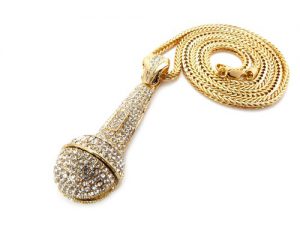
Here’s something to keep in mind: just because a mic is expensive, that doesn’t necessarily equate to the best sound for any given instrument. You must still test all the mics in your arsenal on varying instruments to know where they shine, and where they…get crushed dead beneath the foot of a rampaging mûmak.
The most memorable time I did this was when I was getting ready to record the vocals for my first album. I wanted to make sure I was using the very best mic possible for my voice. That’s the key phrase. It had to make my voice sound amazing, regardless of the specs, the price…or size of staff (go, Gandalf!).
So, I managed to not only set up my own mics, but four other expensive mics that I borrowed from a professional just for this test. Here were my mic shootout wizards, in descending order of cost:
- Neumann U-87 condensor mic, currently selling for $3,599
- AKG C414 XLII condensor mic, currently selling for $949
- Audio-Technica 4050 condensor mic, currently selling for $699
- The RØDE NTK tube condensor mic, currently selling for $529
- Audio-Technica 4033 condensor mic, currently selling for $399
- Shure SM58 dynamic mic, currently selling for $99
- Roland DR-20 dynamic mic, currently not selling new, but used for $60
Now, as you can see, there were some serious contenders there. The U87 alone is considered a ‘holy grail’ of a mic for any studio, and the rest were no slouches either.
I set up the mics, plugged ’em into my recorder (the VS880 at the time it had just premiered), recorded my voice singing one of my new tunes….and then I stopped. To listen.

Headphones really brought it home. There were some really great choices hear. I could have used any of them, for different songs and different approaches. But one clearly made my voice shimmer with a magic that the others only tried to imitate. Can you guess which one it was??
Probably not, because everyone’s voice is different, consisting of varying frequencies that each mic will process in its own way. Amazingly, the one that I ended up recording the album with, the clear winner, was…
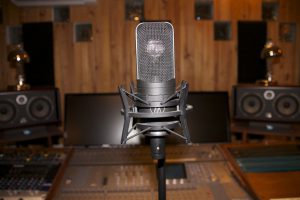
…the AT4050, which I posted an article on HERE!
I remember at the time the ads for this mic featured the prominent, esteemed producer and band leader Alan Parsons recommending it, and, being a long-time fan of Alan’s music, felt that he would be proud of the shoot-out results and I was happy to work under the advice of one of my heroes. Check out the AT4050 price HERE.
Moral of the story? Don’t fall under the illusion spells of expensive mics. Until you’ve heard it on your voice or your instrument, there’s no way to be sure it’s going to compliment your delivery. You must face the wizards….alone!
Throwing Your Sword to the Lady of the Lake

So, which mic is best? The one you have compared to as many others as possible and sound best to your ears on the given instrument.
Take the time to do that and you will not regret it. There are no rules. If it sounds great, it is great. Let your ears be your guide.
After your own personal Battle of the Three Mic Armies, you can take your sword back gently to King Arthur’s underwater girlfriend knowing that the war has ended, and your have the greatest treasure of the spoils of war: the skill of wielding those mics like a master!
Just remember as you create your musical masterpieces, however, the wise words of a modern,muddy sage: “Strange women lying in ponds distributing swords is no basis for a system of government.”
Now, go….make….sounds!
Teaj
